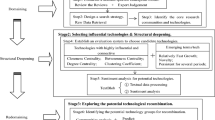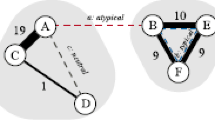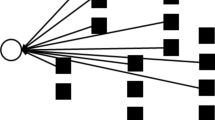Abstract
This research responds to the need for the use of quantitative data and scientific methods for technology opportunity analysis by focusing on idea generation. Interpreting innovation as a process of recombinant search, we propose a patent landscape analysis to generate ideas which are likely to have more novelty and value than others. For this, first, a patent landscape is constructed from patent classification information as a vector space model, where each position represents a configuration of technological components and corresponds to an idea and, if they exist, relevant patented inventions. Second, the novelty of ideas is assessed via the modified local outlier factor based on the distribution of existing patented inventions on the landscape. Finally, the value of ideas is estimated via naïve Bayes models based on the forward citations of existing patented inventions. In addition, this study also investigates the recombinant synergies between different technological components and the relationships between novelty and value of ideas. A case study of pharmaceutical technology shows that our approach can guide organisations towards setting up effective search strategies for new technology development.
Similar content being viewed by others
Notes
For more detailed information, please see the web-based tutorial provided by USPTO (https://www.uspto.gov/video/cbt/ptrcsearching/).
According to the US Patent Classification System-Class Type (http://www.acclaimip.com/the-us-patent-classification-system-class-types/), every US patent has one and only one primary class. It is the class that best describes the invention of a patent. It is double-vetted and reliable since the primary class is used for routing the application through the patent office. If there is a mistake in primary classification, the examiner will reject the patent, and it will be reclassified and routed to a different examiner.
k-fold cross-validation is a statistical technique for assessing how the results of analysis will generalise to an independent data set and how accurately a predictive model will perform in practice. This technique partitions data into k nearly equally sized folds. Subsequently k iterations of training and validation are performed such that, in each iteration, a different fold of the data is held-out for validation while the remaining k-1 folds are used for learning a model. Upon completion, k samples of the performance metric are available and they are combined to derive a more accurate estimate of model performance.
References
Aharonson, B. S., & Schilling, M. A. (2016). Mapping the technological landscape: Measuring technology distance, technological footprints, and technology evolution. Research Policy, 45(1), 81–96.
Alcacer, J., & Gittelman, M. (2006). Patent citations as a measure of knowledge flow: The influence of examiner citations. Review of Economics and Statistics, 88, 774–779.
Arts, S., Cassiman, B., & Gomez, J. C. (2018). Text matching to measure patent similarity. Strategic Management Journal, 39(1), 62–84.
Arts, S., & Fleming, L. (2018). Paradise of novelty: Or loss of human capital? Exploring new fields and inventive output. Organization Science. https://doi.org/10.1287/orsc.2018.1216.
Arts, S., & Veugelers, R. (2015). Technology familiarity, recombinant novelty, and breakthrough invention. Industrial and Corporate Change, 24(6), 1215–1246.
Basalla, G. (1998). The evolution of technology. Cambridge: Cambridge University Press.
Benner, M., & Waldfogel, J. (2008). Close to you? Bias and precision in patent-based measures of technological proximity. Research Policy, 37, 1556–1567.
Bishop, C. M. (2006). Pattern recognition and machine learning. Berlin: Springer.
Breitzman, A., & Thomas, P. (2015). The emerging clusters model: A tool for identifying emerging technologies across multiple patent systems. Research Policy, 44(1), 195–205.
Breunig, M. M., Kriegel, H. P., Ng, R. T., & Sander, J. (2000). LOF: Identifying density-based local outliers. ACM SIGMOD Record, 29(2), 93–104.
Chaudhuri, S. (2005). The WTO and India’s Pharmaceuticals Industry: Patent protection, TRIPS, and developing countries. Oxford: Oxford University Press.
Chen, Y. S., & Chang, K. C. (2010). The relationship between a firm’s patent quality and its market value: The case of US pharmaceutical industry. Technological Forecasting and Social Change, 77(1), 20–33.
Dahlin, K. B., & Behrens, D. M. (2005). When is an invention really radical? Defining and measuring technological radicalness. Research Policy, 34(5), 717–737.
Daim, T. U., Rueda, G., Martin, H., & Gerdsri, P. (2006). Forecasting emerging technologies: Use of bibliometrics and patent analysis. Technological Forecasting and Social Change, 73(8), 981–1012.
Ernst, H. (2003). Patent information for strategic technology management. World Patent Information, 25(3), 233–242.
Fleming, L. (2001). Recombinant uncertainty in technological search. Management Science, 47(1), 117–132.
Fleming, L., & Sorenson, O. (2001). Technology as a complex adaptive system: Evidence from patent data. Research Policy, 30(7), 1019–1039.
Gerken, J. M., & Moehrle, M. G. (2012). A new instrument for technology monitoring: Novelty in patents measured by semantic patent analysis. Scientometrics, 91, 645–670.
Hall, B. H., Jaffe, A., & Trajtenberg, M. (2005). Market value and patent citations. The RAND Journal of Economics, 36(1), 16–38.
Harhoff, D., & Wagner, S. (2009). The duration of patent examination at the European Patent Office. Management Science, 55(12), 1969–1984.
Hoberg, G., & Phillips, G. (2010). Product market synergies and competition in mergers and acquisitions: A text-based analysis. The Review of Financial Studies, 23(10), 3773–3811.
Kauffman, S. (1993). The origins of order. Oxford: Oxford University Press.
Kim, H., Hong, S., Kwon, O., & Lee, C. (2017). Concentric diversification based on technological capabilities: Link analysis of products and technologies. Technological Forecasting and Social Change, 118, 246–257.
Kim, J., Kim, S., & Lee, C. (2019). Anticipating technological convergence: Link prediction using Wikipedia hyperlink. Technovation, 79, 25–34.
Kim, J., & Lee, S. (2015). Patent databases for innovation studies: A comparative analysis of USPTO, EPO, JPO and KIPO. Technological Forecasting and Social Change, 92, 332–345.
Kim, J., & Lee, C. (2017). Novelty-focused weak signal detection in futuristic data: Assessing the rarity and paradigm unrelatedness of signals. Technological Forecasting and Social Change, 120, 59–76.
Lazarevic, A., Ertoz, L., Kumar, V., Ozgur, A., Srivastava, J. (2003). A comparative study of anomaly detection schemes in network intrusion detection. In Proceedings of the 2003 SIAM international conference on data mining (pp. 25–36).
Lee, C., Cho, Y., Seol, H., & Park, Y. (2012). A stochastic patent citation analysis approach to assessing future technological impacts. Technological Forecasting and Social Change, 79(1), 16–29.
Lee, C., Jeon, J., & Park, Y. (2011a). Monitoring trends of technological changes based on the dynamic patent lattice: A modified formal concept analysis approach. Technological Forecasting and Social Change, 78(4), 690–702.
Lee, C., Kang, B., & Shin, J. (2015). Novelty-focused patent mapping for technology opportunity analysis. Technological Forecasting and Social Change, 90, 355–365.
Lee, C., Kim, J., Noh, M., Woo, H. G., & Gang, K. (2017a). Patterns of technology life cycles: Stochastic analysis based on patent citations. Technology Analysis and Strategic Management, 29(1), 53–67.
Lee, Y., Kim, S. Y., Song, I., Park, Y., & Shin, J. (2014). Technology opportunity identification customized to the technological capability of SMEs through two-stage patent analysis. Scientometrics, 100(1), 227–244.
Lee, C., Kwon, O., Kim, M., & Kwon, D. (2017b). Early identification of emerging technologies: A machine learning approach using multiple patent indicators. Technological Forecasting and Social Change, 127, 291–303.
Lee, C., & Lee, H. (2015). Novelty-focussed document mapping to identify new service opportunities. Service Industries Journal, 35(6), 345–361.
Lee, M., & Lee, S. (2017). Identifying new business opportunities from competitor intelligence: An integrated use of patent and trademark databases. Technological Forecasting and Social Change, 119, 170–183.
Lee, C., Kwon, O., Kim, M., & Kwon, D. (2018). Early identification of emerging technologies: A machine learning approach using multiple patent indicators. Technological Forecasting and Social Change, 127, 291–303.
Lee, H. J., Lee, S., & Yoon, B. (2011b). Technology clustering based on evolutionary patterns: The case of information and communications technologies. Technological Forecasting and Social Change, 78(6), 953–967.
Lee, C., Park, H., & Park, Y. (2013a). Keeping abreast of technology-driven business model evolution: A dynamic patent analysis approach. Technology Analysis and Strategic Management, 25(5), 487–505.
Lee, C., Song, B., & Park, Y. (2009a). Generation of new service concepts: A morphology analysis and genetic algorithm approach. Expert Systems with Applications, 36(10), 12454–12460.
Lee, C., Song, B., & Park, Y. (2013b). How to assess patent infringement risks: A semantic patent claim analysis using dependency relationships. Technology Analysis and Strategic Management, 25(1), 23–38.
Lee, S., Yoon, B., & Park, Y. (2009b). An approach to discovering new technology opportunities: Keyword-based patent map approach. Technovation, 29(6), 481–497.
Lerner, J. (1994). The importance of patent scope: An empirical analysis. RAND Journal of Economics, 25, 319–333.
Lewis, D. D. (1998). Naive (Bayes) at forty: The independence assumption in information retrieval. In European conference on machine learning (pp. 4–15).
Narin, F., Noma, E., & Perry, R. (1987). Patents as indicators of corporate technological strength. Research Policy, 16(2–4), 143–155.
Nelson, R. R., & Winter, S. (1982). An evolutionary theory of economic change. Cambridge: Harvard University Press.
Park, Y., & Yoon, J. (2017). Application technology opportunity discovery from technology portfolios: Use of patent classification and collaborative filtering. Technological Forecasting and Social Change, 118, 170–183.
Rosenberg, N. (1979). Technological interdependence in the American economy. Technology and Culture, 20(1), 25–50.
Schilling, M. A., & Green, E. (2011). Recombinant search and breakthrough idea generation: An analysis of high impact papers in the social sciences. Research Policy, 40(10), 1321–1331.
Schumpeter, J. (1939). Business cycles. New York: McGraw-Hill.
Son, C., Suh, Y., Jeon, J., & Park, Y. (2012). Development of a GTM-based patent map for identifying patent vacuums. Expert Systems with Applications, 39(3), 2489–2500.
Strumsky, D., & Lobo, J. (2015). Identifying the sources of technological novelty in the process of invention. Research Policy, 44(8), 1445–1461.
Tan, P. N. (2006). Introduction to data mining. Delhi: Pearson Education India.
Trajtenberg, M. (1990). A penny for your quotes: patent citations and the value of innovations. The RAND Journal of Economics, 21(1), 172–187.
Usher, A. (1954). A history of mechanical invention. Cambridge, MA: Dover.
USPTO. (2006). Overview of the US patent classification system (USPC), electronic document at http://www.uspto.gov.
Wang, X., Ma, P., Huang, Y., Guo, J., Zhu, D., Porter, A. L., et al. (2017). Combining SAO semantic analysis and morphology analysis to identify technology opportunities. Scientometrics, 111(1), 3–24.
Wang, H. G., Wu, Z., Meng, F. L., Ma, D. L., Huang, X. L., Wang, L. M., et al. (2013). Nitrogen-doped porous carbon nanosheets as low-cost, high-performance anode material for sodium-ion batteries. Chemsuschem, 6(1), 56–60.
Woo, H. G., Yeom, J., & Lee, C. (2018). Screening early stage ideas in technology development processes: A text mining and k-nearest neighbours approach using patent information. Technology Analysis and Strategic Management. https://doi.org/10.1080/09537325.2018.1523386.
Yoon, J., & Kim, K. (2012). Detecting signals of new technological opportunities using semantic patent analysis and outlier detection. Scientometrics, 90(2), 445–461.
Yoon, B., & Park, Y. (2005). A systematic approach for identifying technology opportunities: Keyword-based morphology analysis. Technological Forecasting and Social Change, 72(2), 145–160.
Yoon, B., & Park, Y. (2007). Development of new technology forecasting algorithm: Hybrid approach for morphology analysis and conjoint analysis of patent information. IEEE Transactions on Engineering Management, 54(3), 588–599.
Yoon, J., Park, H., & Kim, K. (2013). Identifying technological competition trends for R&D planning using dynamic patent maps: SAO-based content analysis. Scientometrics, 94(1), 313–331.
Yoon, B., Phaal, R., & Probert, D. (2008). Morphology analysis for technology roadmapping: Application of text mining. R&D Management, 38(1), 51–68.
Yoon, B., Yoon, C., & Park, Y. (2002). On the development and application of a self–organizing feature map–based patent map. R&D Management, 32(4), 291–300.
Acknowledgements
This work was supported by the National Research Foundation of Korea (NRF) Grants funded by the Korea Government (MSIP) (No. 2017R1C1B2011434).
Author information
Authors and Affiliations
Corresponding author
Appendices
Appendix 1: Patent landscapes for pharmaceutical technology


Appendix 2: Pseudo code of the proposed approach


Rights and permissions
About this article
Cite this article
Lee, C., Lee, G. Technology opportunity analysis based on recombinant search: patent landscape analysis for idea generation. Scientometrics 121, 603–632 (2019). https://doi.org/10.1007/s11192-019-03224-7
Received:
Published:
Issue Date:
DOI: https://doi.org/10.1007/s11192-019-03224-7







